“When we are young, the words are scattered all around us. As they are assembled by experience, so also are we, sentence by sentence, until the story takes shape.” ― Louise Erdrich
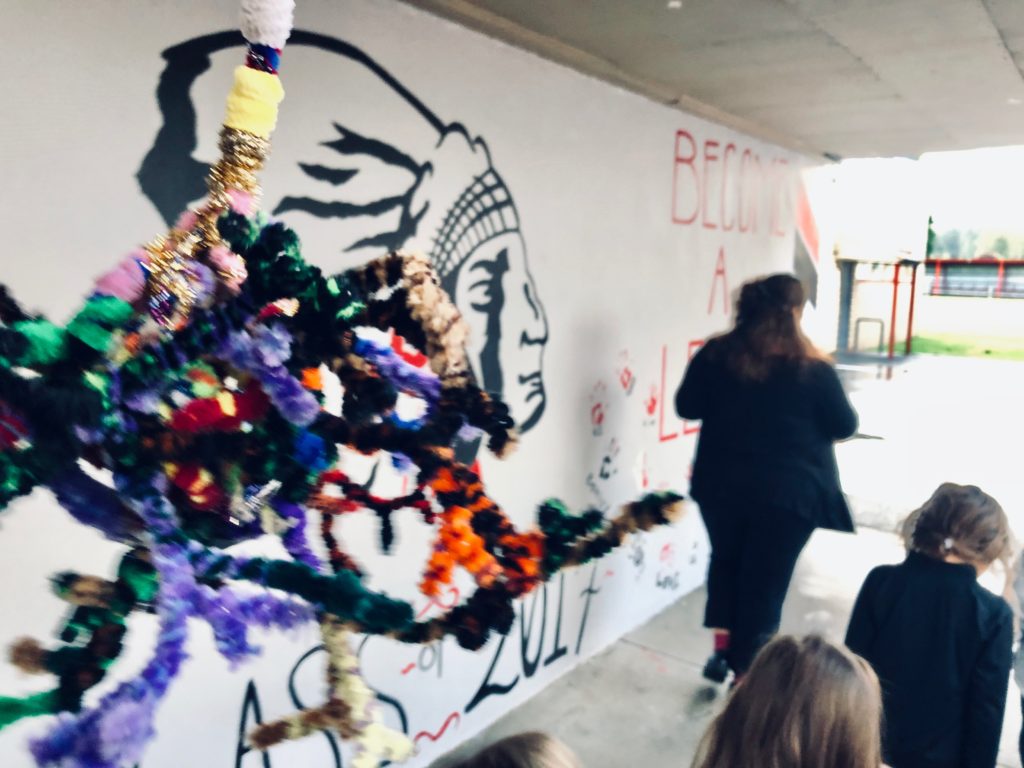
UPDATE (3/2021): We are so excited to return to Siletz next fall, for a potentially live, in person physically distanced day of outreach, brains & art! Volunteers at the PDX 3D Printing Lab printed 20 woodpecker red+ brains for teachers, thanks to Hatchbox PLA supplied by the Portland Alcohol Research Center at OHSU!

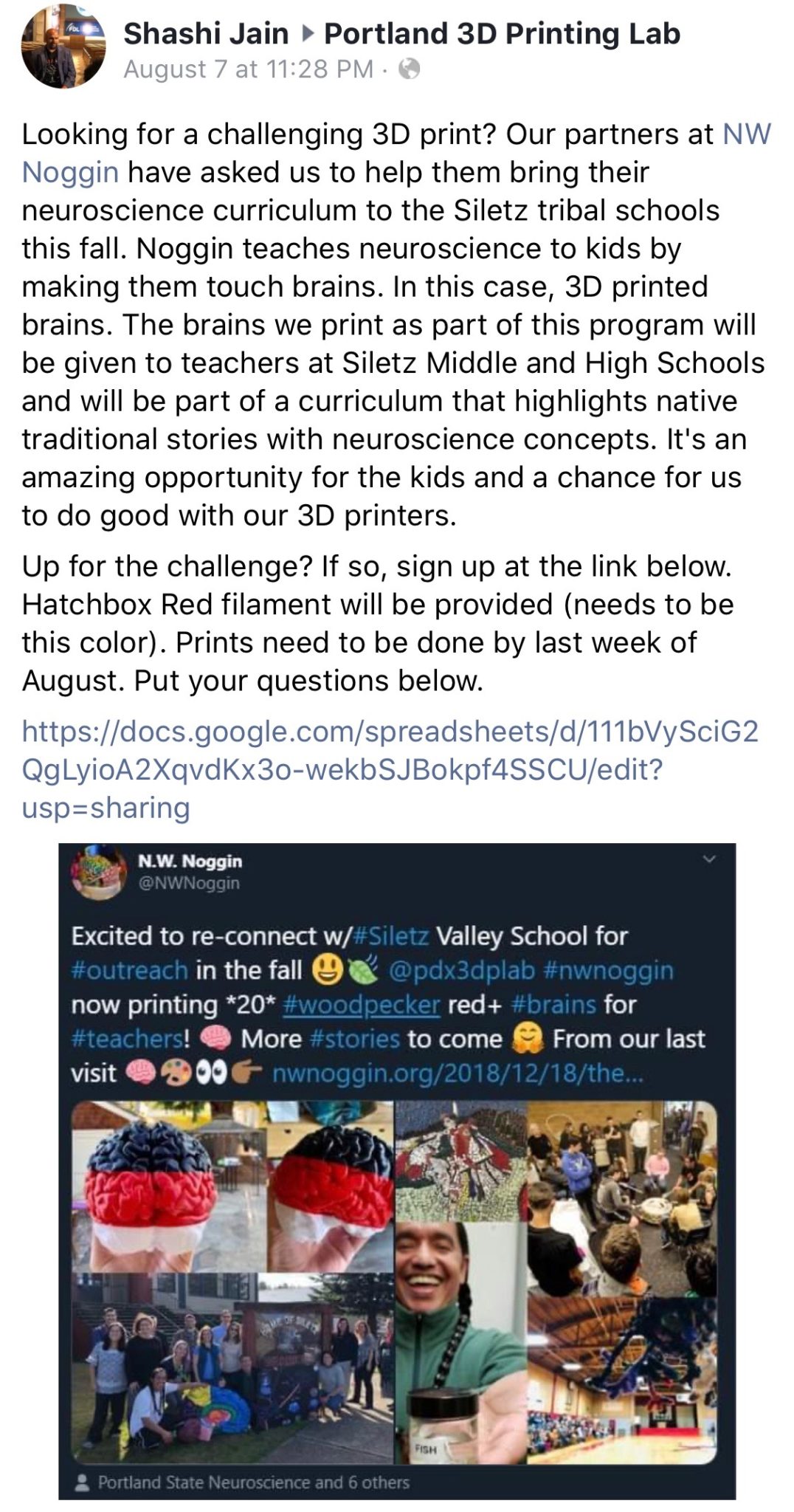
In the meantime, please enjoy this stunning beaded brain cell, hand-stitched by Dee-ni’ Language and Culture teacher Theresa Smith!

Did you know that Native tales describe language and tool use by Raven, and Crow? What do the travails of Little Raccoon tell us about our own behavior, and our own brains? What makes these stories compelling, memorable, instructive, thrilling, engaging, motivating, and fun?
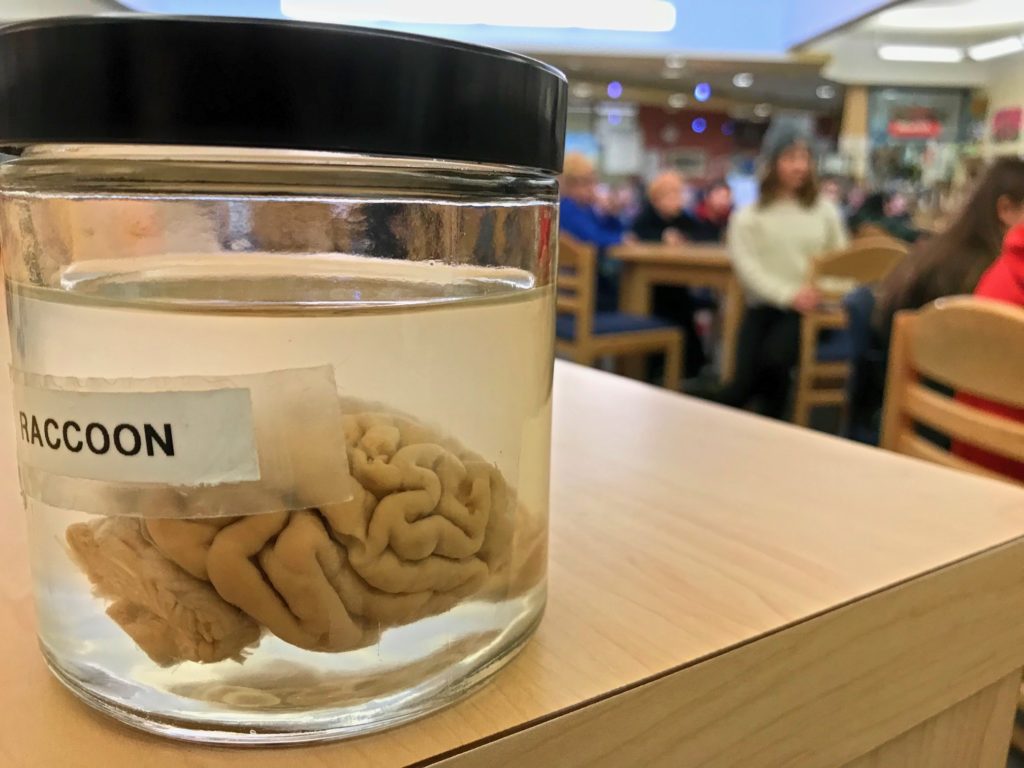
We offer sincere thanks and appreciation to Mychal Cherry, Angela Sears, Jesse Knight and Marissa Leno of Spirit Mountain Community Fund (SMCF), which supported our NW Noggin proposal for Synapses, Stories & Song: Coyote, Grizzly & their Brains!
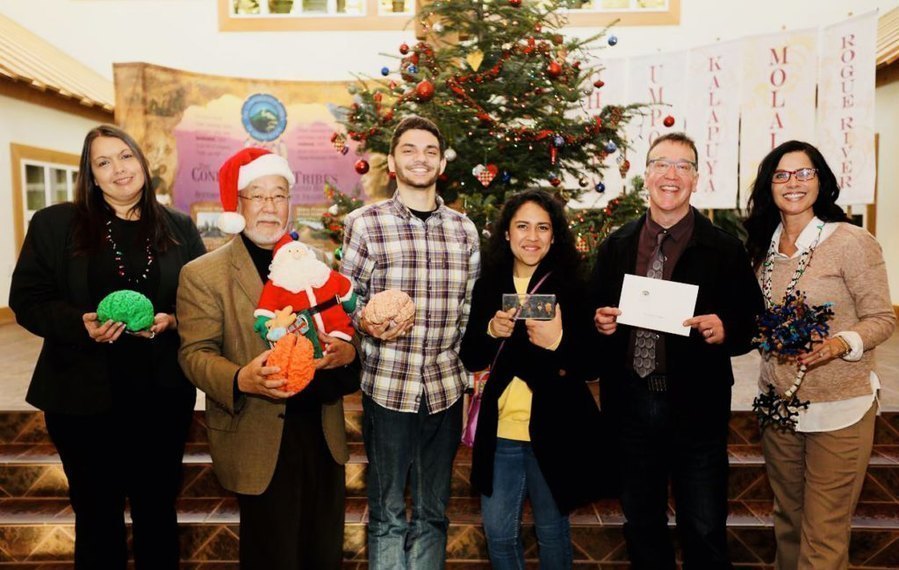
We were honored to receive funding for outreach with tribal majority schools, aimed at making connections between animal figures in Grande Ronde and Siletz stories and relevant neuroscience research. Thanks to their investment, we engaged with over 300 K-12 students in three tribal majority schools through exploration of brain anatomy, storytelling, music and art!
LEARN MORE: Synapses, Stories & Song: Coyote, Grizzly & their Brains!

NW Noggin volunteers at Siletz Valley Early College Academy, October 2018
There is tremendous regional and national need to develop programs and approaches which successfully engage “academic priority” students, and offer access to the social and economic benefits of further education…
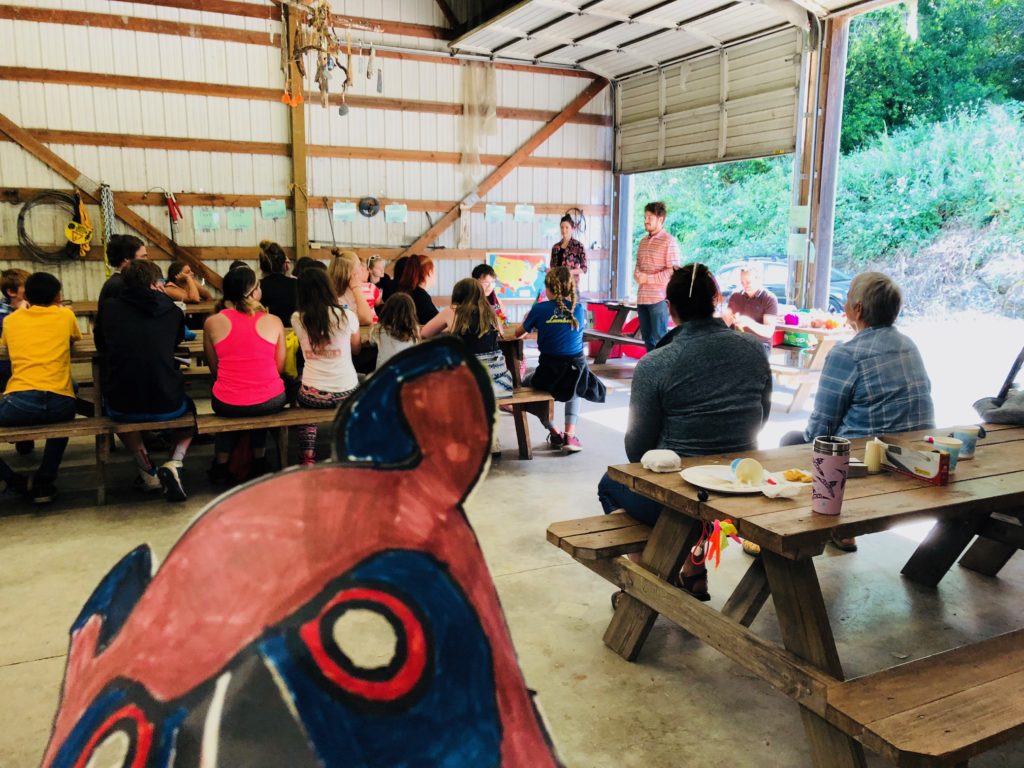
NW Noggin volunteers at Meservy Meadows, July 2018
Many K-12 students struggle with academic achievement, and become disenchanted with school. The dropout rate for Native American students is particularly high.
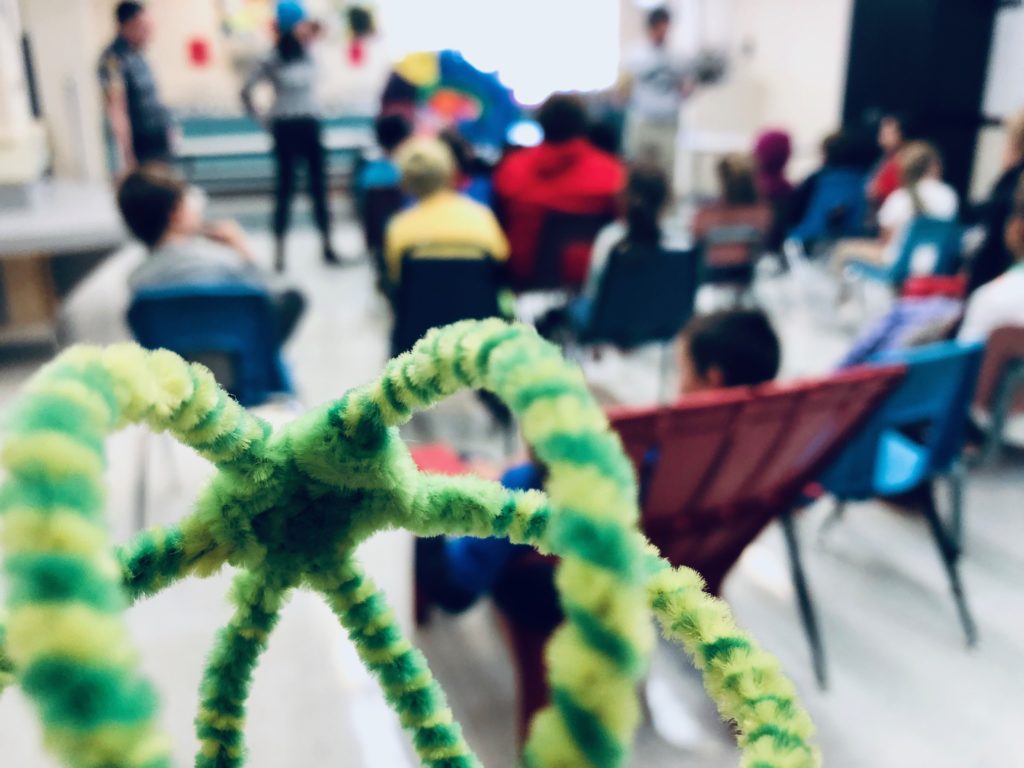
Oregon has a rich Native American culture and history, yet only in 2017 did the Legislature mandate development of a statewide curriculum for K-12 students covering ‘tribal history, tribal sovereignty, culture, treaty rights, government, socioeconomic experiences, and current events.’
LEARN MORE: American Indian/Alaska Native Students in Oregon: A Review of Key Indicators
LEARN MORE: Oregon’s Native American students face obstacles to stay in, complete school
LEARN MORE: State of Oregon Tribal Attendance Pilot Projects
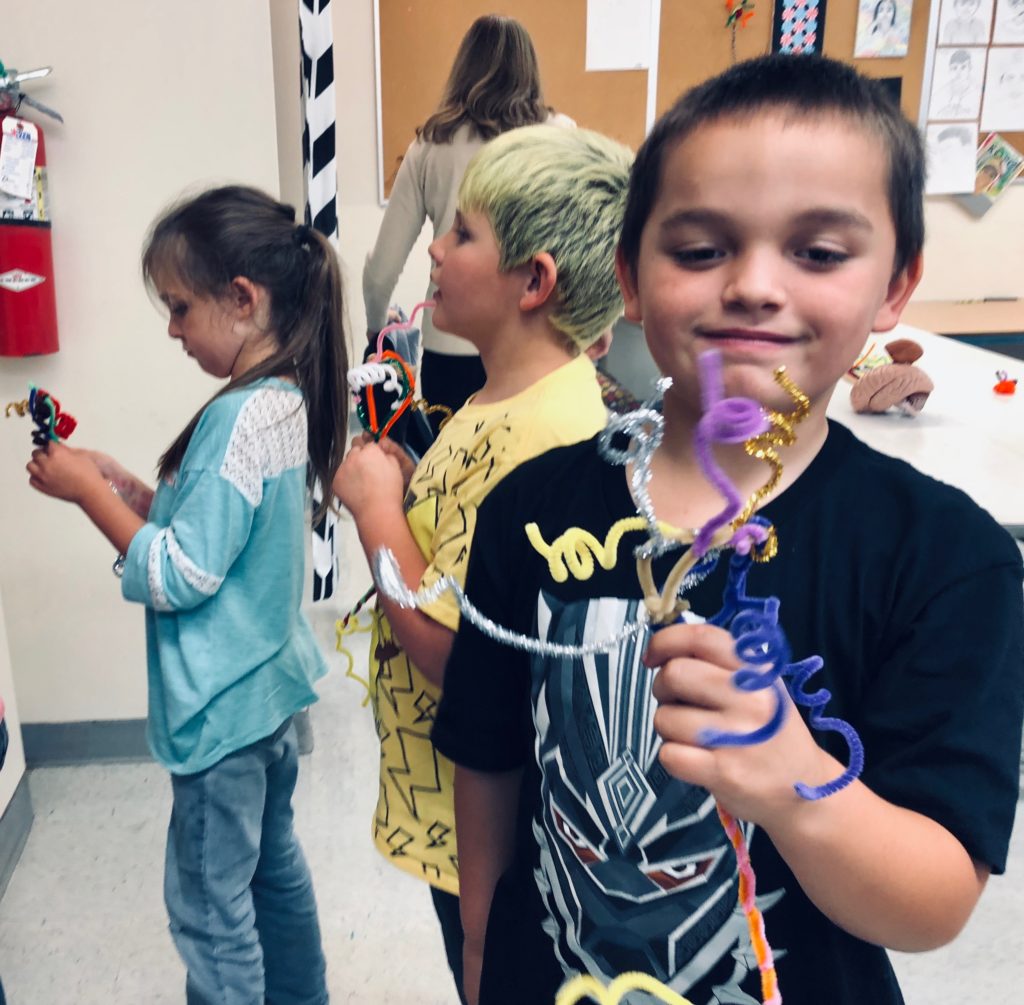
“You’re both the fire and the water that extinguishes it. You’re the narrator, the protagonist, and the sidekick. You’re the storyteller and the story told. You are somebody’s something, but you are also your you.” ― John Green, Turtles All the Way Down
Our ongoing volunteer efforts to bring together “near peers,” including undergraduates in both science and the arts, to collaborate with graduates in creating novel, innovative, multidisciplinary methods of explaining complex ideas in neuroscience, exposes students to scientists and artists at various stages of their careers.
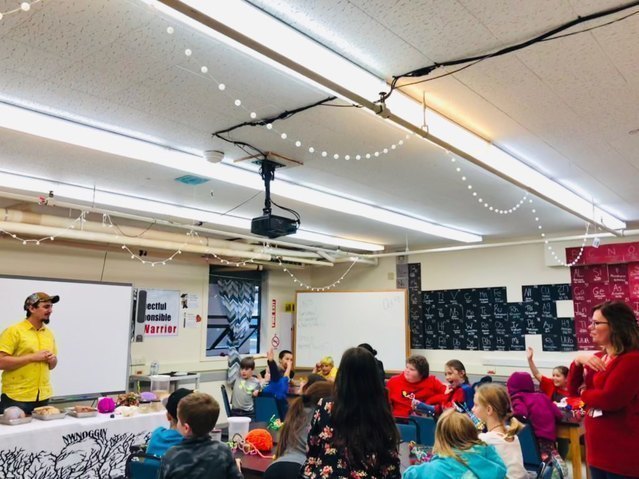
Building community connections – and brain networks too!
Going where we are not the experts, and listening, and inviting people to ask the questions, tell their own stories, and describe what they already know offers opportunities for dialogue and for sharing our own accounts of relevant research. It challenges our biases, and helps better train brain networks critical for developing essential implicit skills, like seeing others, and storytelling…
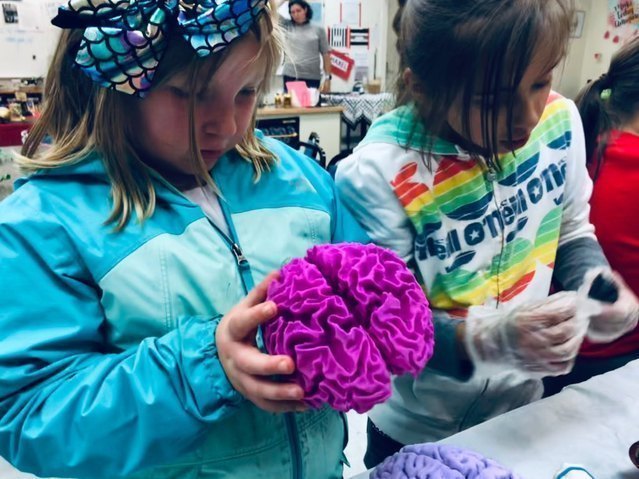
LEARN MORE: Synapsing in San Diego @ SfN!
With support from Spirit Mountain, we spent much of spring 2018 collaborating with Joanne Trzcinski and Melanie Alvarado of the Oregon Pacific Area Health Education Center (OPAHEC), making visits to meet with students, teachers and staff at Siletz Valley Early College Academy, and Amity and Willamina High Schools…
Noggin @ Siletz Valley
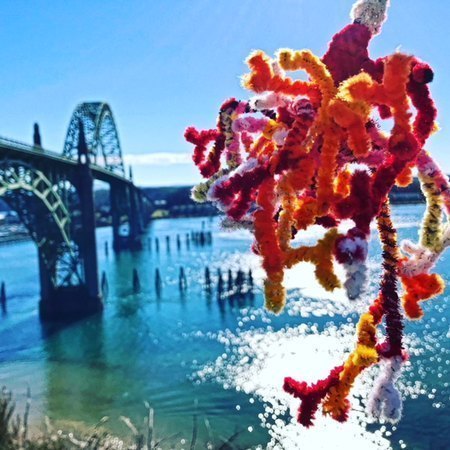
Tres Escuelas en un Día!

Brains are xumxum @ Willamina
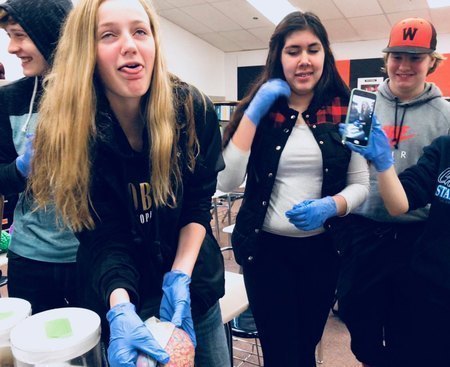
Noggin + Storytelling + Song @ Siletz

During the summer of 2018, we were thrilled to join Esther Stutzman, an award-winning Oregon storyteller who organizes an annual gathering for young Native Americans, now in its 42nd year, and tells traditional Coos and Kalapuya tales.
Siletz Stories, Singing, Dancing & Brains!
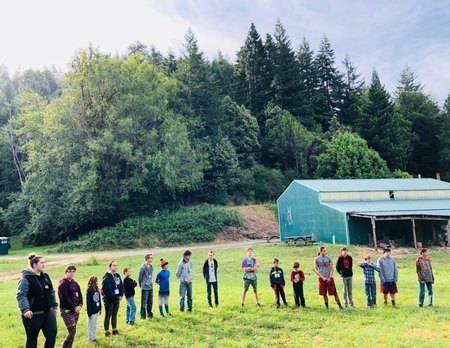
We also collaborated with Andrew Hardy and Michael and Miguel Pierre of BioGift to dissect out both the brains and skulls of animal heads donated by Wayne Sherrard of Wayne’s Taxidermy in Yoncalla, Oregon…
Living like bears
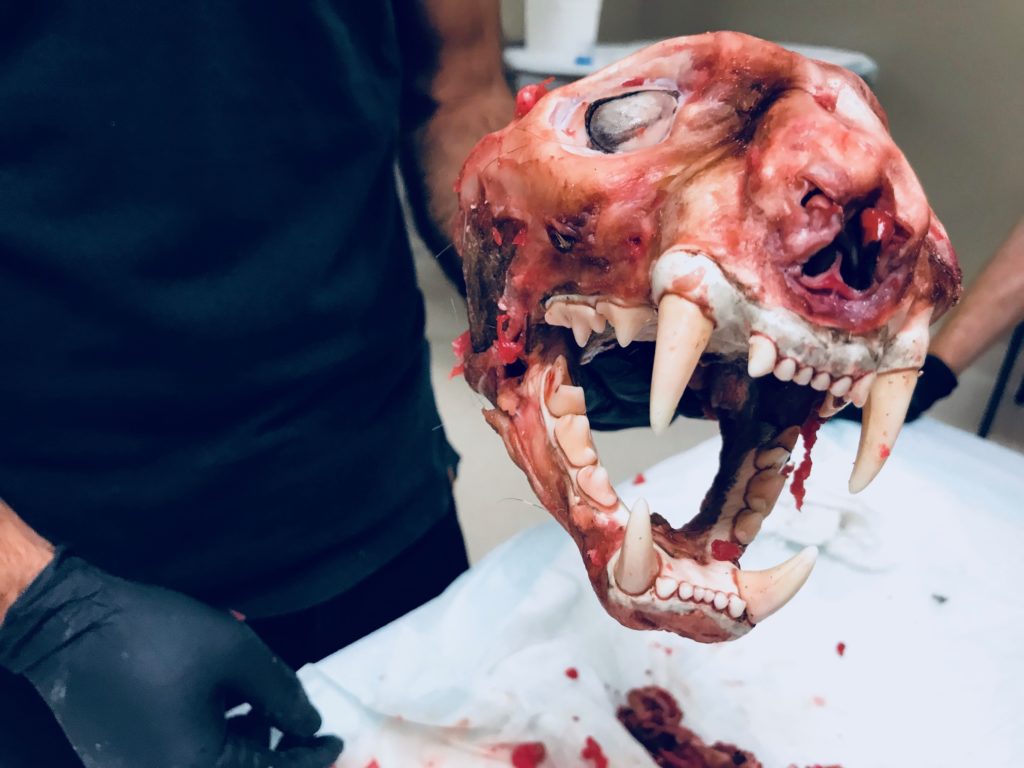
Cougar skull at BioGift. “Science is not opposed to storytelling. Science is a genre of storytelling. Stories of the real world, inspired by observations thereof.” – Sean Carroll
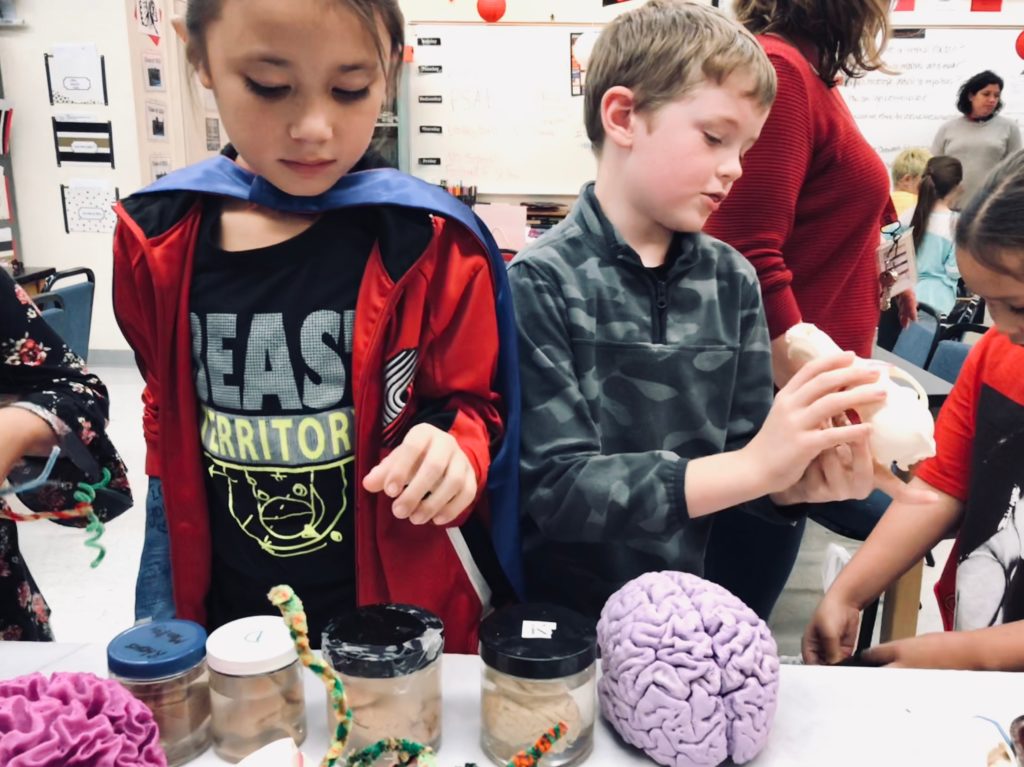
And for three days in October (8 – 11), again thanks to the Spirit Mountain Community Fund, our Noggin volunteers from Portland State University and Oregon Health & Science University brought real brains (animal and human), and art projects into classrooms in Siletz, Amity and Willamina schools..!
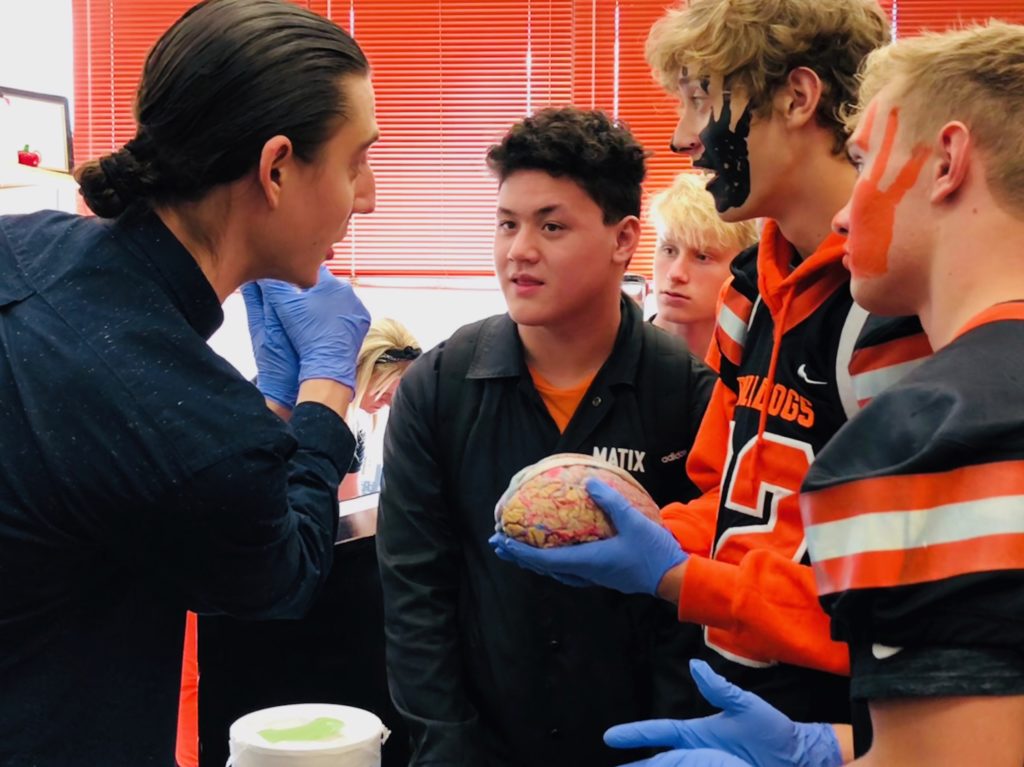
NW Noggin volunteers at Willamina High School, October 2018
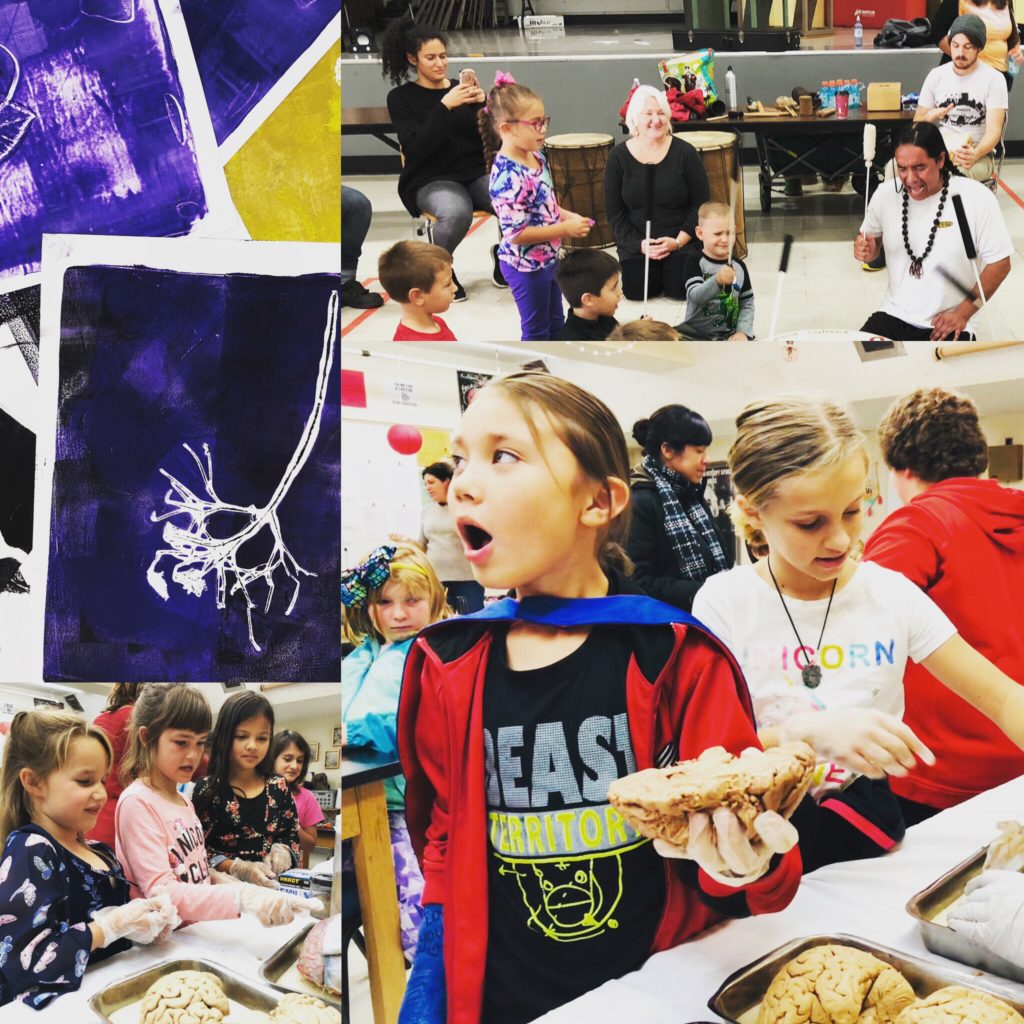
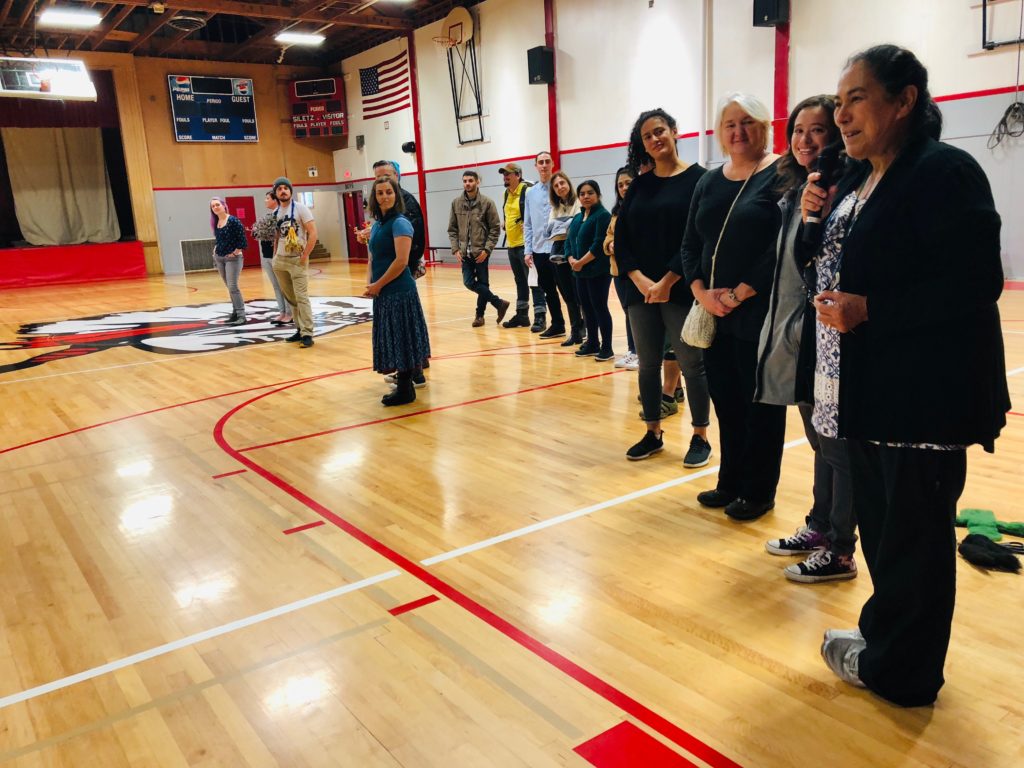
NW Noggin volunteers at Siletz Valley Early College Academy, October 2018

“I’ve never seen the entire school so interested, so excited – and so quiet! – during an assembly” – Theresa Smith, Culture Teacher, Siletz Valley
We were over the moon excited to welcome Fish Martinez, aka 28 Tha Native, who joined us for all three days to tell stories, answer questions, hold brains, and connect with students through drumming, music, poetry and art!
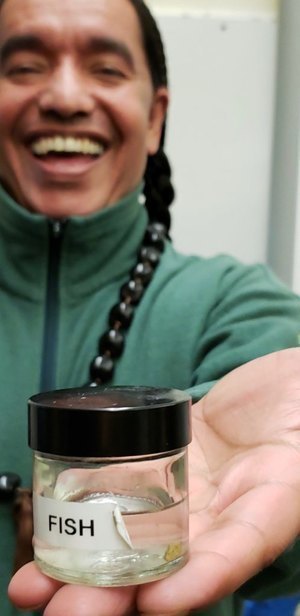
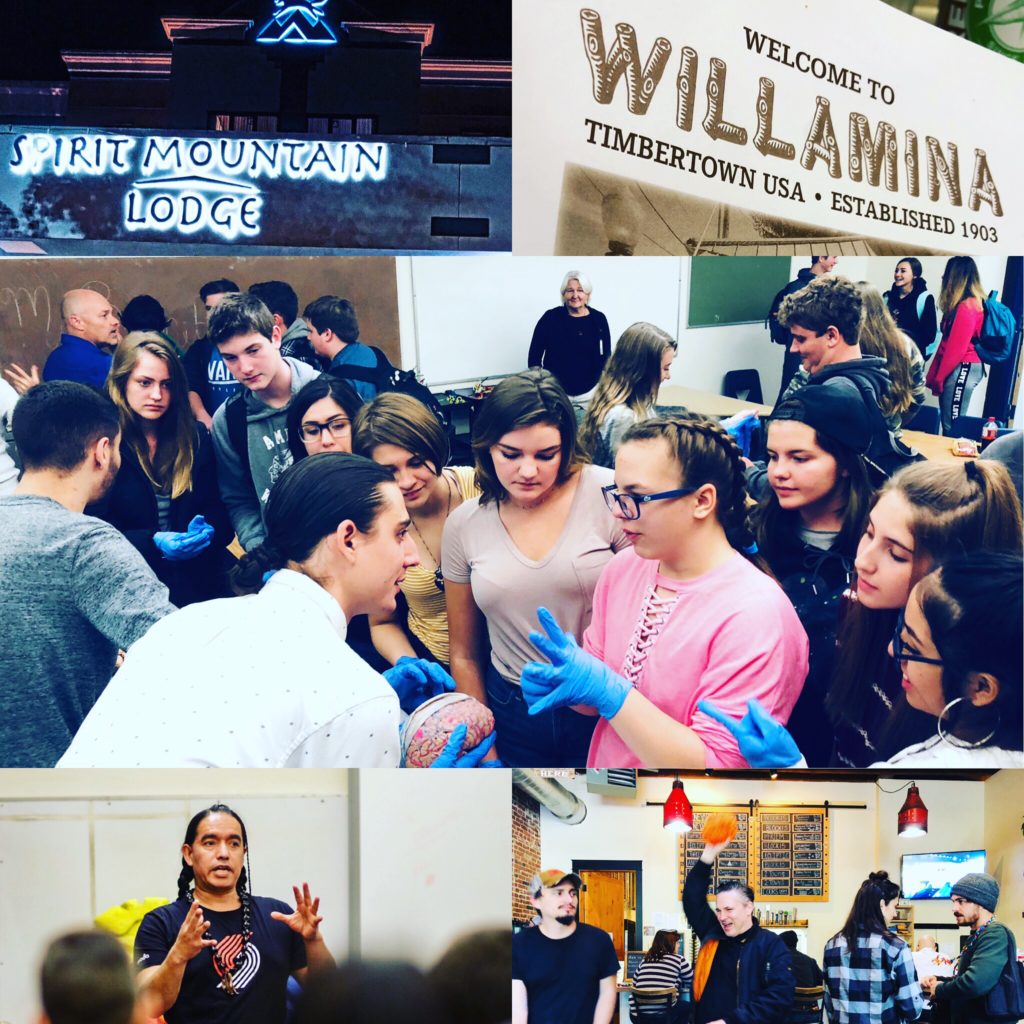
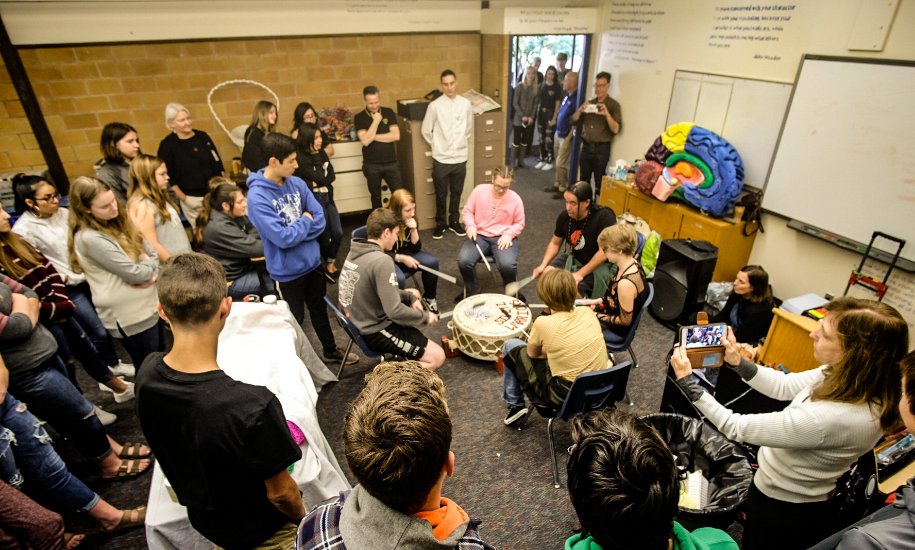
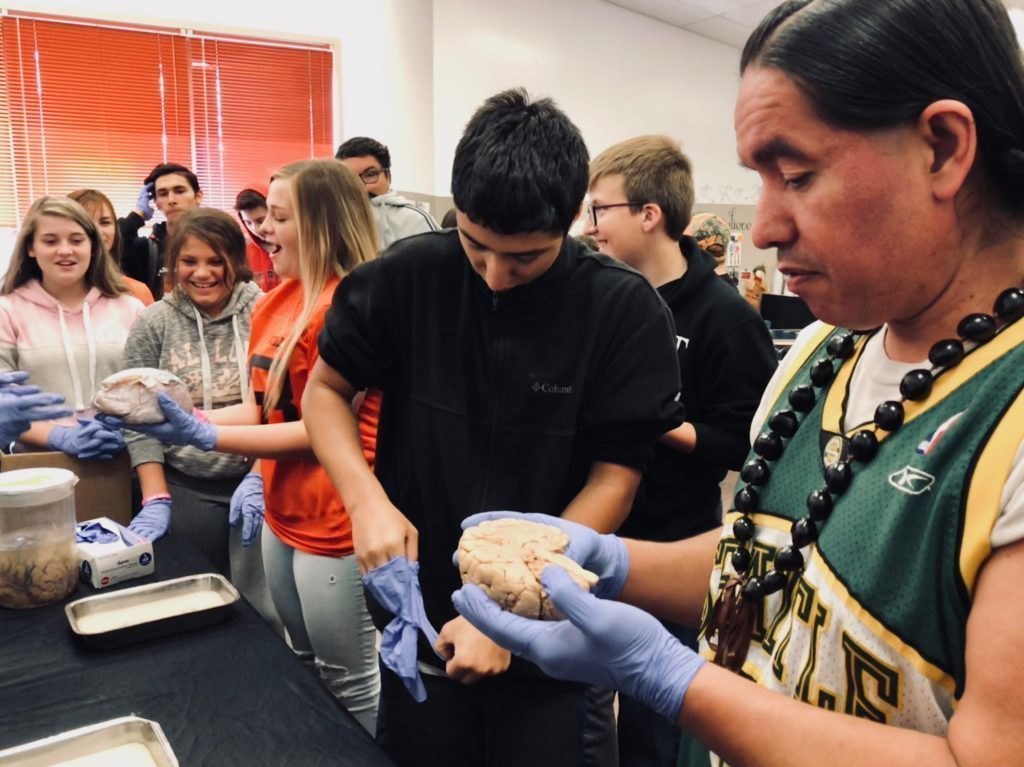
“You don’t have anything if you don’t have the stories.” ― Leslie Marmon Silko
Fish told the compelling Wasco tale of Little Raccoon and his Grandmother, a story he’d learned from his own grandmother, Mrs. Alice Florendo – a story she’d first heard as a child along the Columbia River. This story had both kids and adults enthralled at all three schools!
Little Raccoon just can’t help himself from eating the sweet, juicy acorns his grandmother has stored for the winter, with hilarious results. This is a classic example of impulsive behavior and the difficulty we all have in delaying gratification by considering consequences and then inhibiting those actions that only bring short term, but not long term gains…
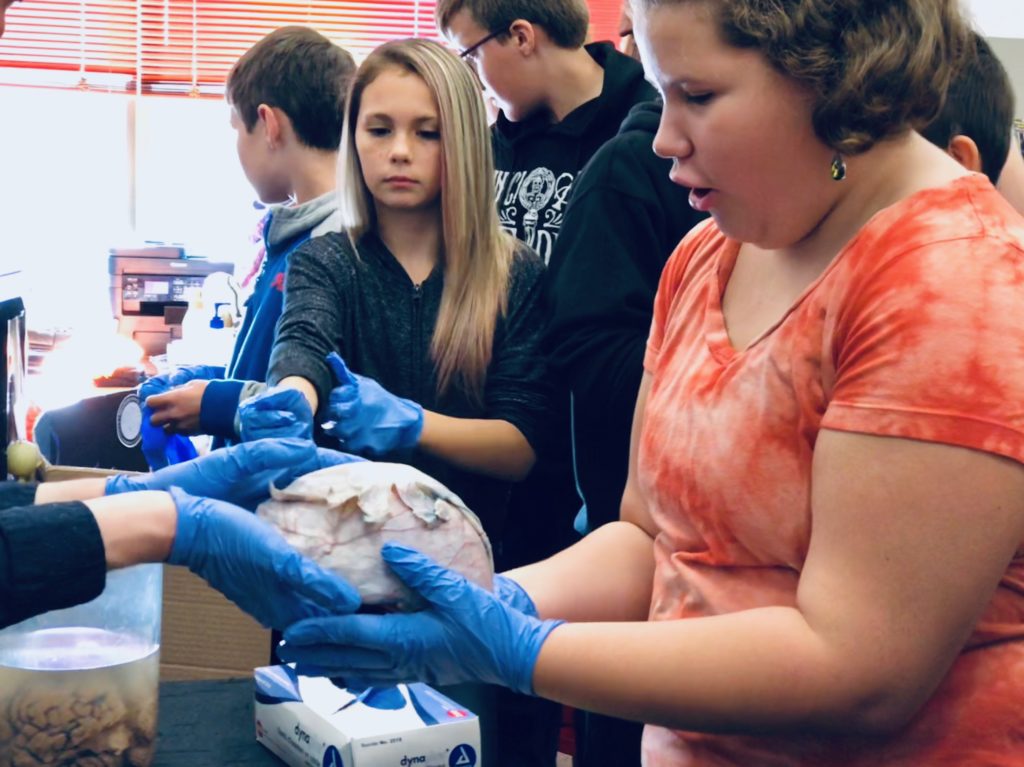
This is particularly hard for young people with developing brains. It is hard to coordinate long range networks, many involving regions of the frontal lobes, to make good choices. Stories offer us training in actions and consequences, as we viscerally experience the self-inflicted travails of Little Raccoon and his eventual comeuppance. Stories are guides, and roadmaps, and structurally and functionally change neural networks to reflect the social and cultural expectations of our own community…
LEARN MORE: Maturation of the adolescent brain
CURIOUS ABOUT RACCOON BRAINS & BEHAVIOR?
LEARN MORE: Trickster Brains @ Shahala
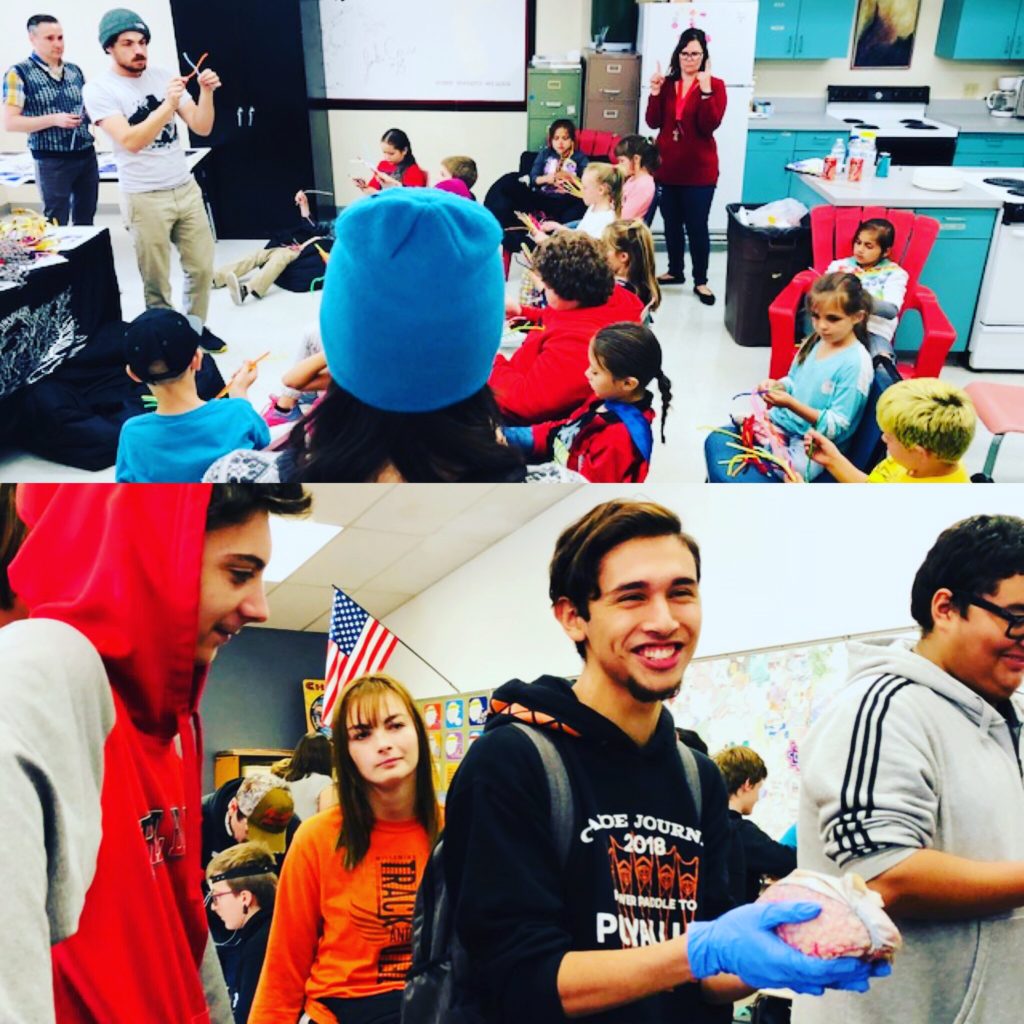
“People are hungry for stories. It’s part of our very being. Storytelling is a form of history, of immortality too. It goes from one generation to another.” – Studs Terkel
In addition, we were honored to welcome talented puppeteer Ana Lucia Mello, who has worked with the Nez Perce tribe to create puppets for telling their stories. She had students equally engrossed in tales from her native Brazil during our first day at Siletz…
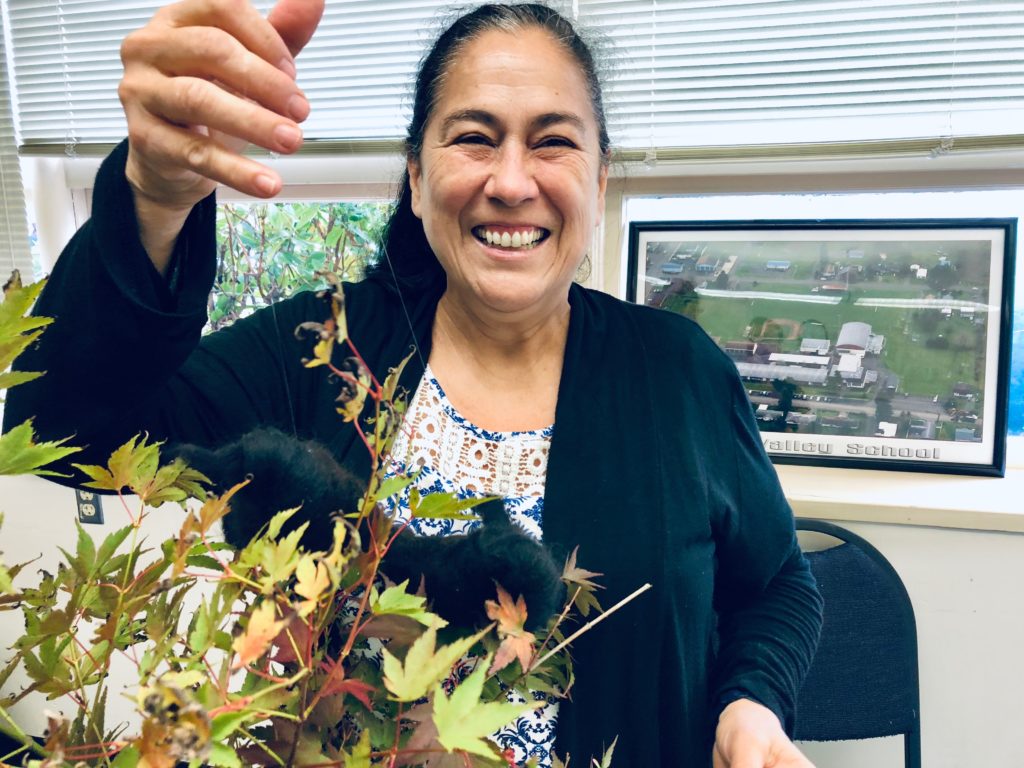
We are also thrilled to continue our collaboration with Shashi Jain, an Innovation Manager and Startup Program Lead at Intel, and with the Intel Native American Employees Network (INAN), whose members generously prepared a prototype “Noggin Brain Box” filled with outreach project instructions, pens, paper, 3D printed brain models – and (of course!) pipe cleaners!
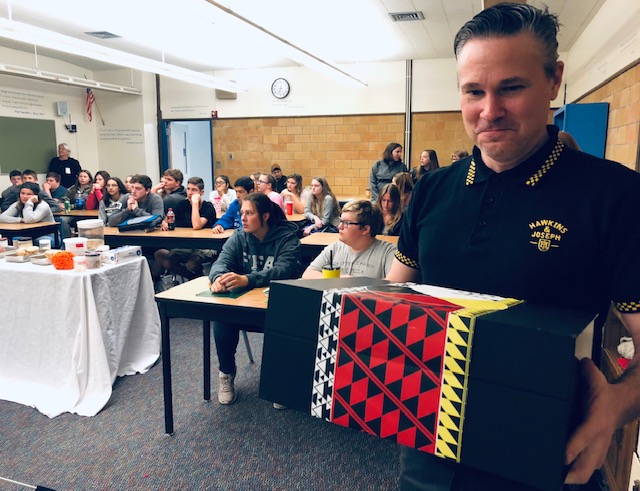
LEARN MORE: NW Noggin STEAM Art Projects
Because of these outreach connections, area Native artists were invited to contribute works for display at the Intel Jones Farm campus in November and December this year! Learn more about this ongoing collaboration (and how our brains are and are not like computers!) at the following link…
The Tracks We Leave
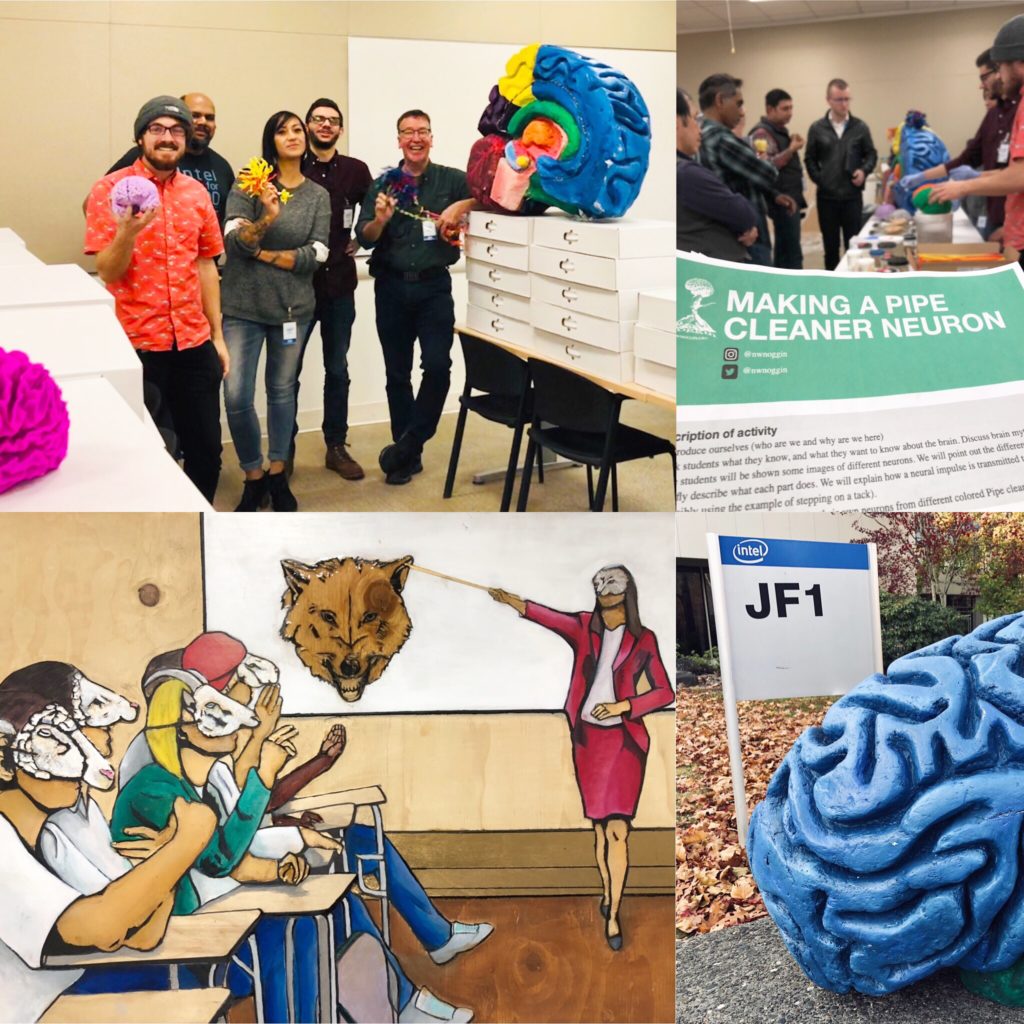
“After nourishment, shelter and companionship, stories are the thing we need most in the world.” – Philip Pullman
The Spirit Mountain Community Fund “Synapses & Stories” grant allowed us to reach more than 300 students and covered three days of housing and meals for the following participants: Ana Lucia Mello, Ana Sofia Mello and Fish Martinez, Leota Wolford, Aaron Eisen, Sulema Rodriguez, Jordan Ray, Ashley Keates and Sara Moreno from Portland State University, Jacob Schoen, Sami Friedrich and Denesa Lockwood from OHSU, and Joey Seuferling, Jeff Leake and Bill Griesar of NW Noggin…
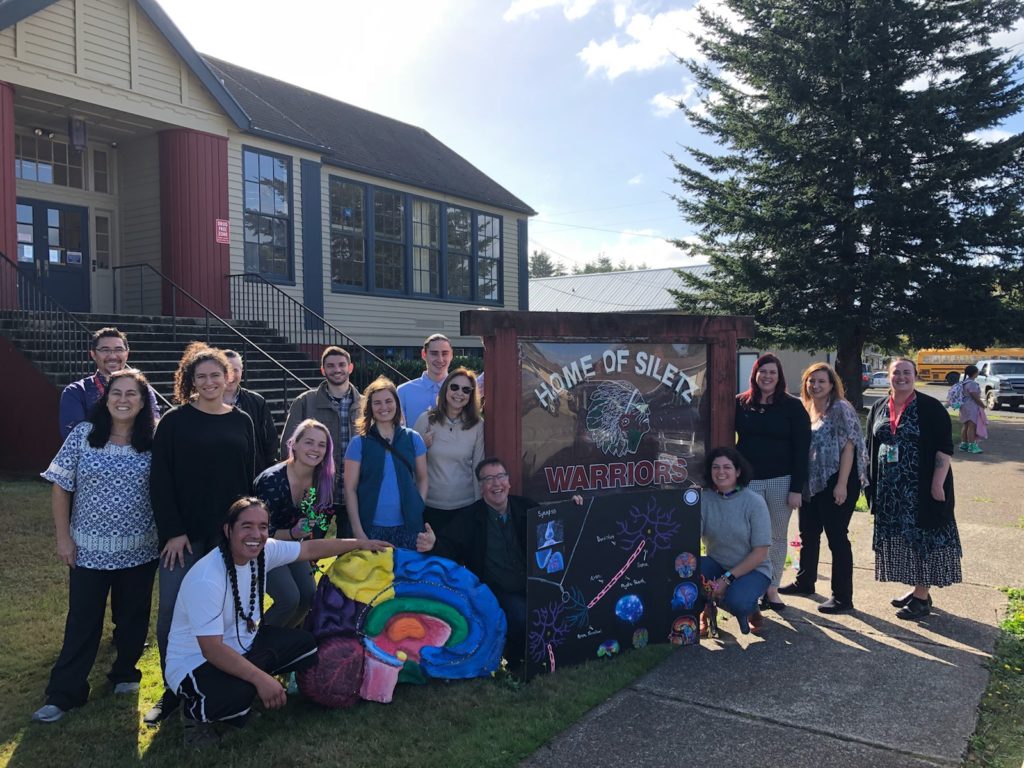
Among the most generous, devoted and accomplished volunteers around (at Siletz)..!
It also paid for essential art supplies and MANY boxes of nitrile gloves…
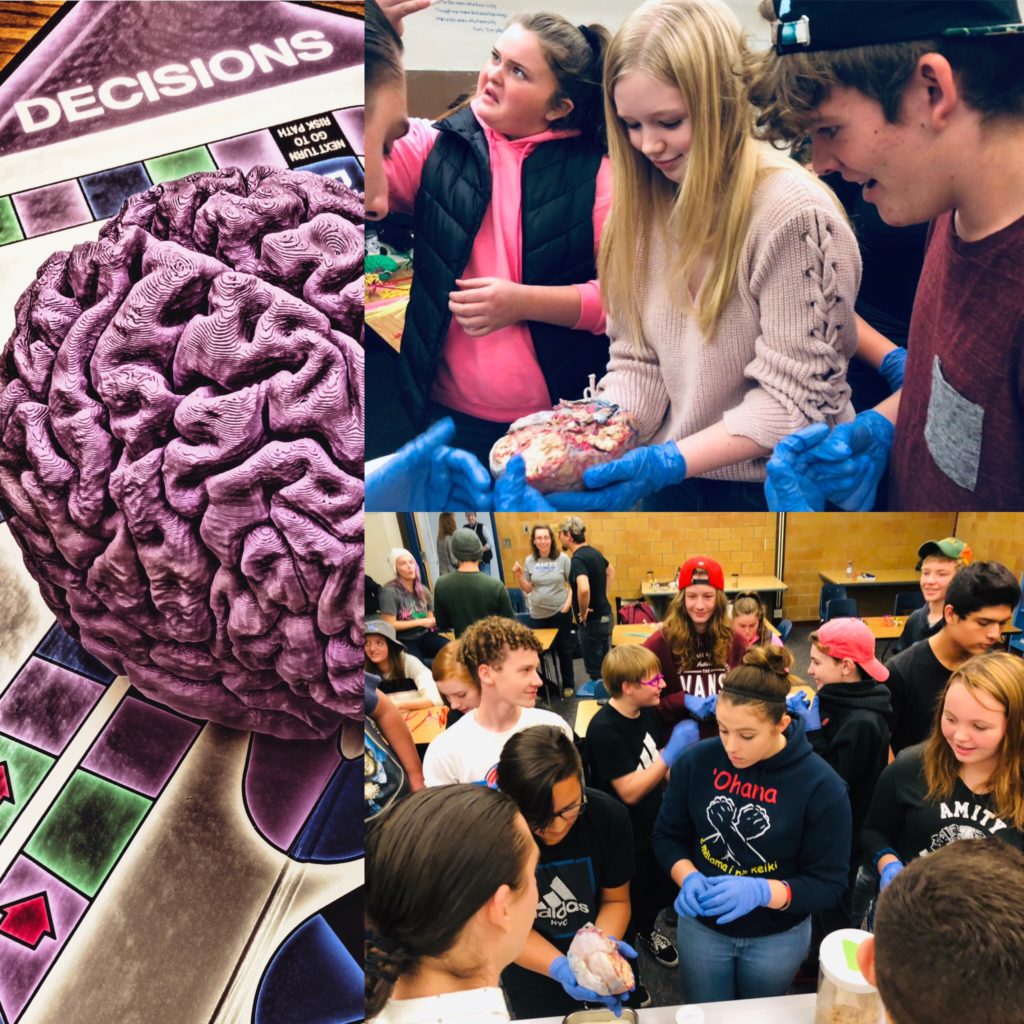

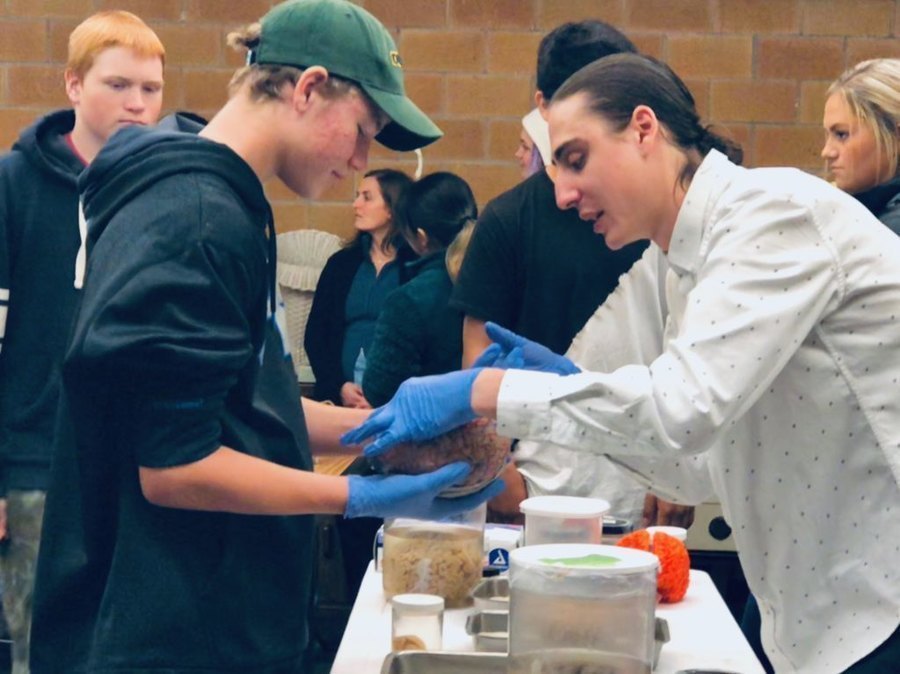
“It’s like everyone tells a story about themselves inside their own head. Always. All the time. That story makes you what you are. We build ourselves out of that story.” – Patrick Rothfuss
OPAHEC and Noggin also brought students from Siletz, Willamina and Amity to OHSU for a tour of the MRI imaging facilities in September 2018, to expand their knowledge of healthcare and research career options. We are planning to collaborate on future outreach projects in the Oregon Pacific region…
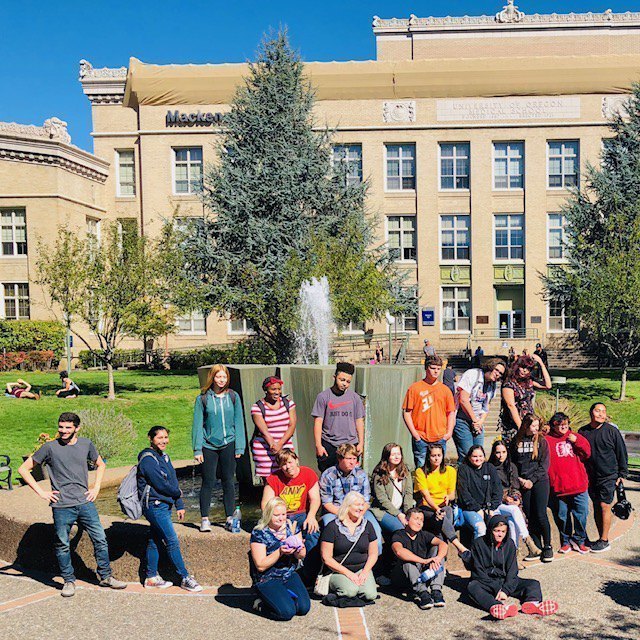
Joanne Trzcinski of OPAHEC wrote about her experiences in the following post…
Joanne Trzcinski on Synapses, Stories & Song!
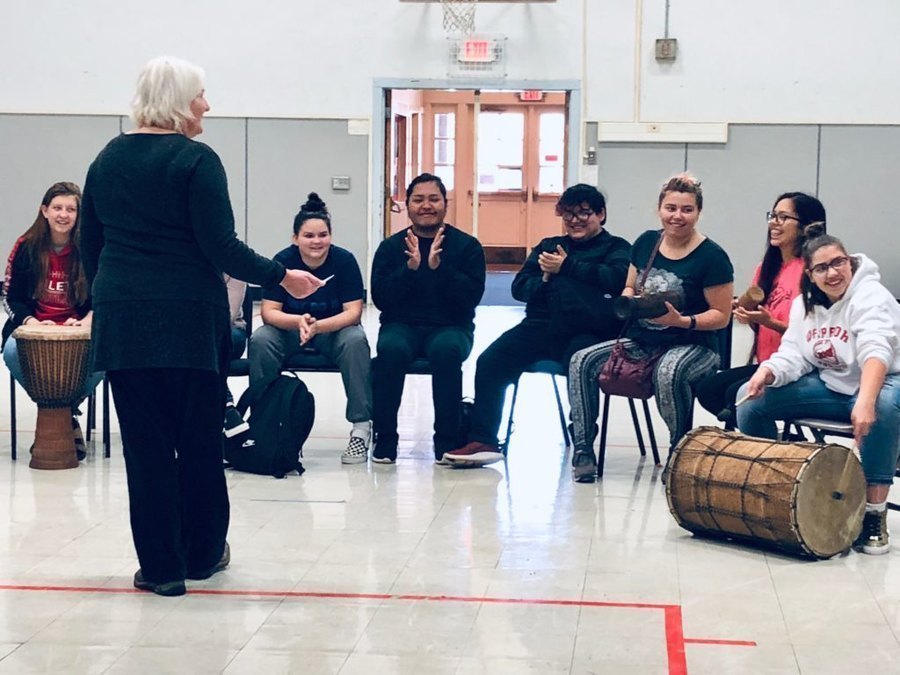
Noggin was also honored to welcome Catherine Caine, a second grade teacher at Waikiki Elementary, the 2015 Teacher of the Year in Hawaii, and one of four finalists for National Teacher of the Year!
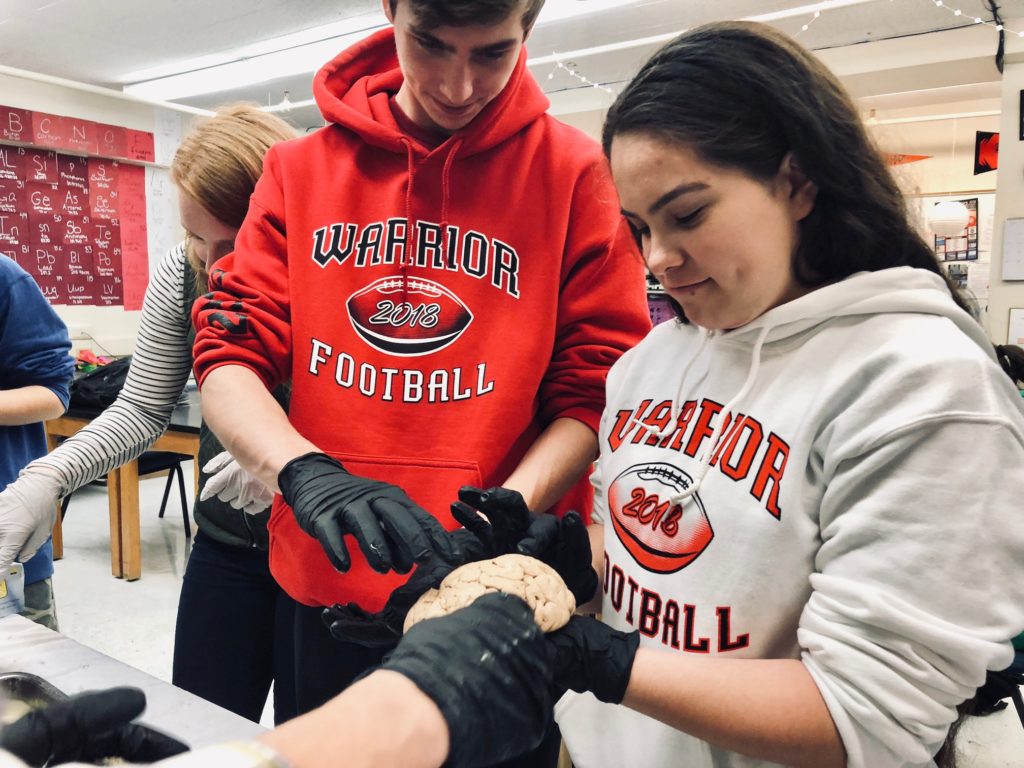
Catherine joined us for three days of #ontheroad STEAM outreach, and wrote about her own experiences in the following post…
In the Spirit of Learning
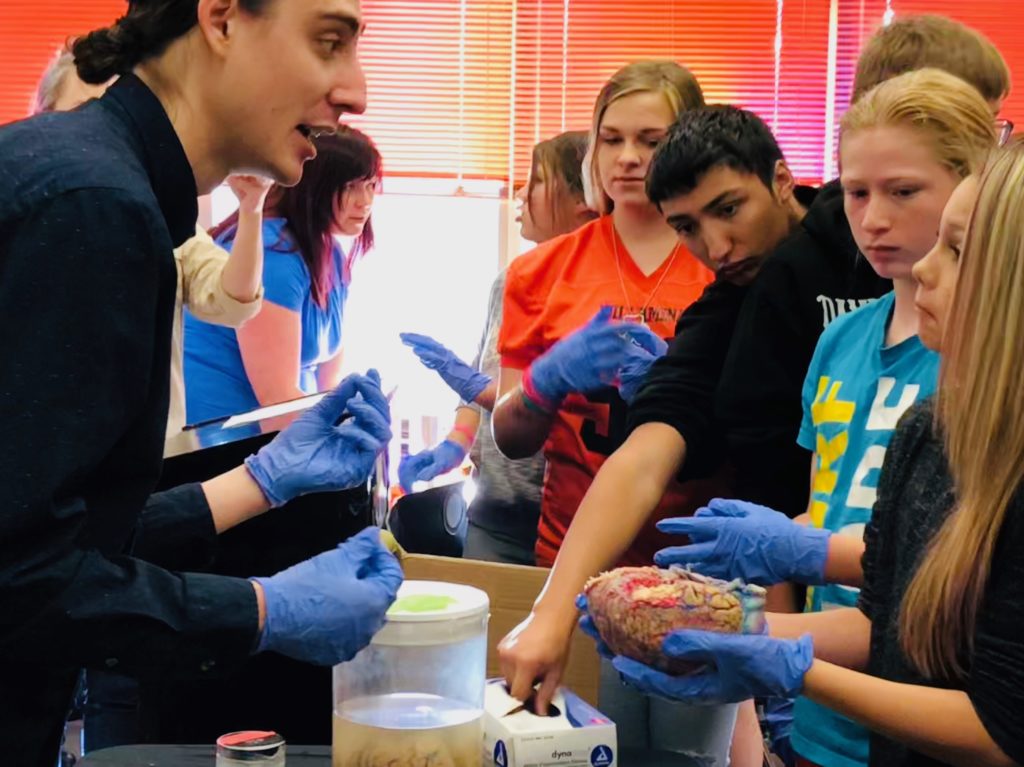
“You’re never going to kill storytelling, because it’s built into the human plan. We come with it.” – Margaret Atwood
Once again, our huge thanks to everyone at the Spirit Mountain Community Fund for their support of arts-integrated neuroscience outreach, and the shaping of stories, networks and connections in our own communities and brains!


